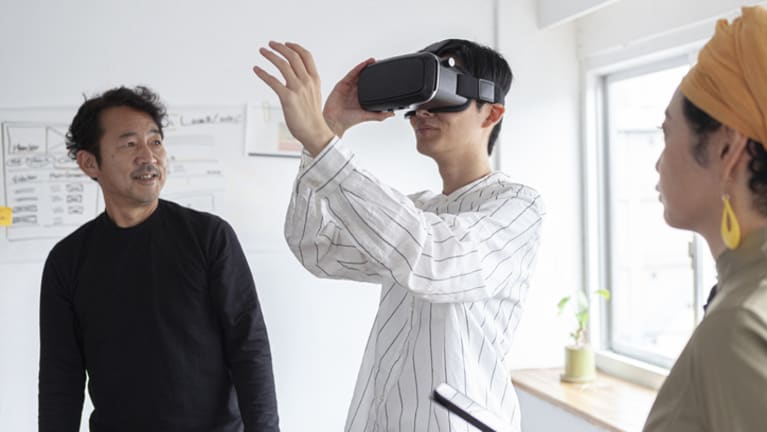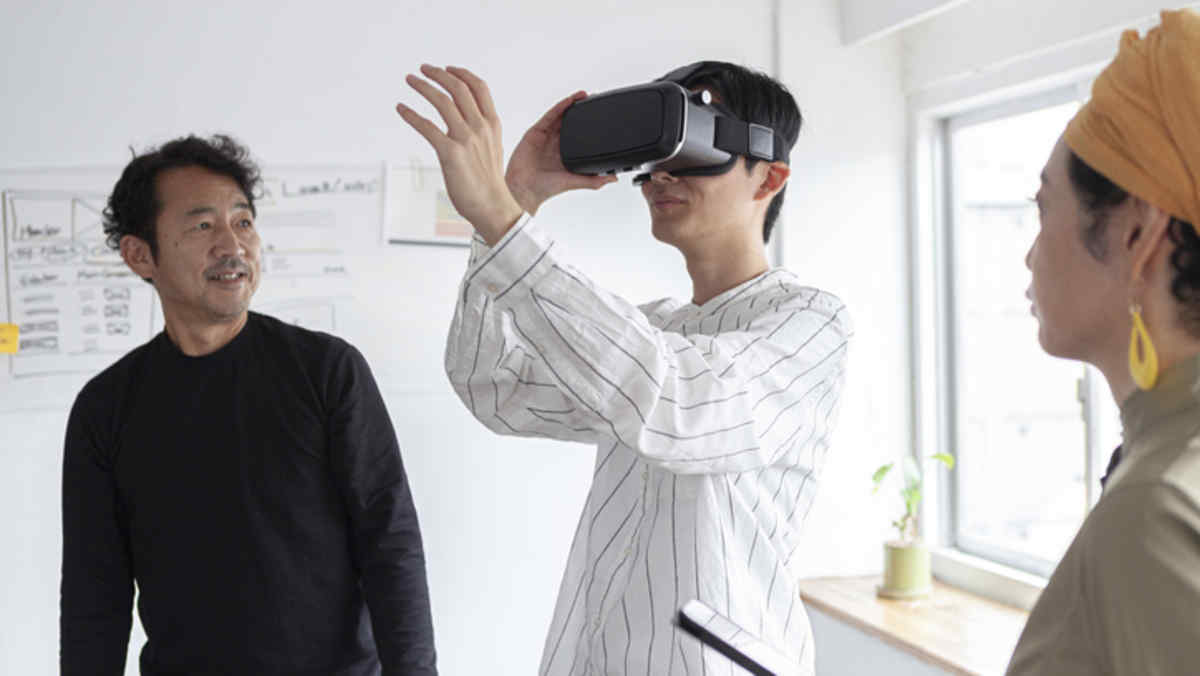

At the beginning of June, Apple released a promotional trailer for its new product, Apple Vision Pro. This mixed-reality headset computer was pitched as a way to change how we interact with technology and improve our daily lives at work and at home. Users can navigate with their hands, eyes and voice, as well as replace their computers, tablets and other devices with the headset. Once they are available in 2024, Apple Vision Pro headsets will cost $3,499 each.
Now that companies have seen a preview of the Apple Vision Pro’s capabilities, some cutting-edge HR professionals are starting to think about how this new virtual reality (VR) product will be applicable in the workplace. Some initial feedback reflects highest interest in leveraging the technology to improve employee relations, interact more effectively with customers and increase productivity, among other practical applications, such as:
Recruiting Candidates
When Krystal Khali, CEO at Spacebourne Inc., an aerospace company in Austin, Texas, heard about the Apple Vision Pro, she was excited to test it out for recruitment.
“In the area of HR, Spacebourne will be using the Apple Vision Pro to hire and screen applicants,” she said. “As an aerospace corporation, our screening process is significantly more involved than it is for most industries. Our hiring process includes various rigorous testing modules.”
Khali and her team plan to utilize the headset to interview potential candidates in distant geographical regions.
“We can meet face to face with a broader range of recruits because no one needs to fly in,” she said. “It’s a more immersive experience for team members, including both candidates and hiring managers.”
As a result of these immersive meetings, Khali hopes to reach talent around the globe.
“[It] ensures that Spacebourne attracts the best minds from various backgrounds and locations,” she said. Additionally, during the recruitment process, Khali will test candidates’ skills using the headset to see how they react to emergency scenarios.
“We can put someone in a simulated capsule and have them carry out emergency sequences to test how they will react to rehearsed as well as novel scenarios,” she said. “This is part of our hiring and screening evaluation process, which can often take months before someone is officially hired.”
Improving Training
Stacy Elmore, co-founder at The Luxury Pergola, a pergola manufacturer in Indianapolis, imagines that she will use the Apple Vision Pro not only to replace computer monitors, which take up a lot of office space, but also for training purposes.
“From an HR perspective, it would be beneficial to use this in training—if apps support it—to make the standard HR training more real,” she said. “We could actually place our employee in various scenarios and show them how best practices are demonstrated in the workplace. This is much more relatable than watching a standard video.”
While Elmore is enthusiastic about the release of the product, she said she’s “even more excited to see how developers support the device for an enterprise application.”
At Spacebourne, Khali plans to use Apple Vision Pro for crew simulation and training, which could bolster safety in the workplace.
“[It] can potentially provide pilots, astronauts and ground crew with realistic environments, including cockpits and off-earth habitats,” she said. “Simulated environments can help crew practice maneuvers, physically train on emergency procedures and run through various scenarios before ‘the real thing.’ VR training can potentially significantly reduce costs in all areas in aerospace and enhance personnel safety.”
Boosting Sales and Service
Virtual-reality headsets can help customers visualize what a room is going to look like with a prospective product installed, which is exactly what Chris Alexakis, CEO and HR director at Cabinet Select, is counting on. He employs 15 people at his Venice, Florida company, which sells cabinets, and hopes to use the Apple Vision Pro to help customers see how the cabinets will look before buying.
“For products like furniture, where visualization is key, tools like Apple Vision Pro could prove invaluable,” Alexakis said. “Customers could use AR [augmented reality] to see how a cabinet fits before making a purchase or how well they like a sofa in their space. This could drastically improve the shopping experience and potentially reduce returns,” as well as improve customer relations.
“I believe that adopting the Apple Vision Pro, and similar advanced technologies, is part of a bigger picture of digital transformation,” he added. “It’s an exciting time to be at the intersection of retail and technology, and we’re eager to explore all possibilities that can bring us closer to our customers.”
Improving Design
At Spacebourne, Khali is going to implement Apple Vision Pro into her team’s design operations as they use the headset for the prototyping of spacecraft and components. That way, their engineers can interact with and visualize 3D models before physically producing them.
“This can allow them to conduct design evaluation, identify issues and make adjustments before any physical, and costly, production takes place,” she explained.
Enhancing Remote Work
Alexakis imagines that he’ll be using the Apple Vision Pro for members of his remote team so they can feel more connected to their colleagues and jobs.
“It would be nice to not actually be outside of your house, but still get the feel of an office while you attend meetings,” he said. “And it’s going to make collaboration so much easier too, because you work better with someone who’s not a blank screen to you.”
Elmore echoed a similar sentiment. “I expect this will help with remote work, as the fidelity on the device is unparalleled and could help bring teams from all over the world together with ease,” she said. “For many people, I expect that it will help them create a better work/life balance by offering more manageable work from home.”
While Khali is anticipating the arrival of the Apple Vision Pro, she knows it could take time for Apple to perfect it. She has used Google Glass and Oculus, which are similar VR headsets, and was not impressed, but is hopeful that Apple can change the headset industry.
“The functionality and interoperability of these headsets is not really there yet, but I think it will be soon,” she said. “When certain kinks are worked out, we will be using it.”
Kylie Ora Lobell is a freelance writer based in Los Angeles.

